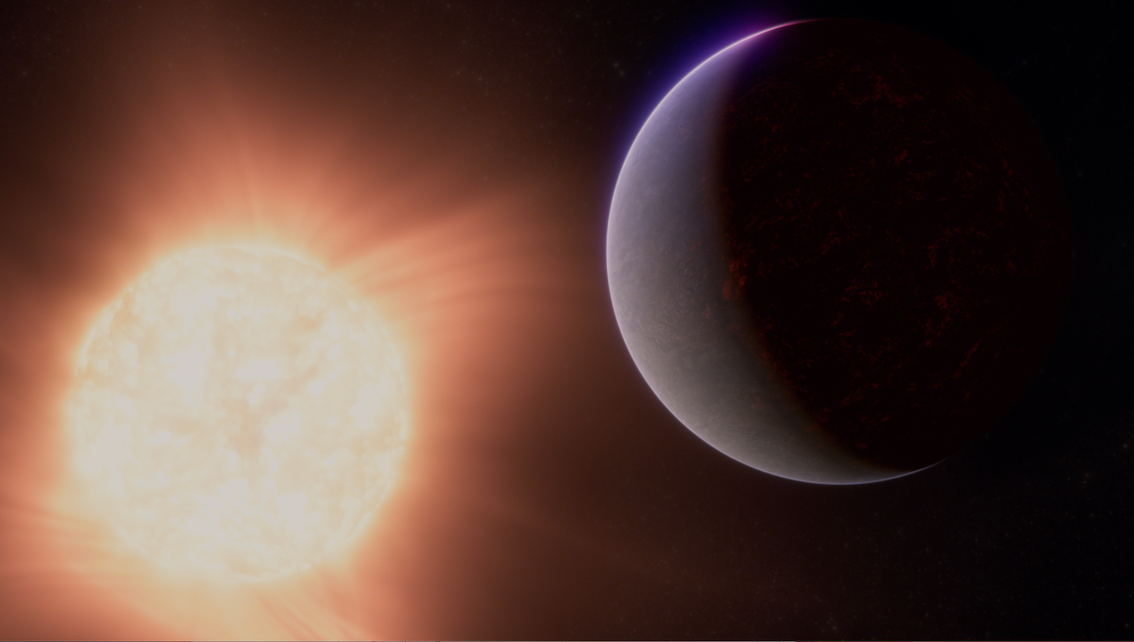
First Evidence for the Atmospheres of the Super-Earth Cancri e
Researchers using the James Webb Space Telescope (JWST) have unveiled the first evidence of an atmosphere around the rocky exoplanet 55 Cancri e, located 41 light-years from Earth. This discovery marks a significant milestone in exoplanet research, providing the most compelling evidence of an atmosphere on a rocky planet outside our Solar System.
55 Cancri e is one of five known planets orbiting a Sun-like star in the constellation Cancer. It is approximately twice the diameter of Earth and nine times its mass, fitting into the “super-Earth” category, which describes exoplanets larger than Earth but smaller than Neptune and composed of rock similar to the terrestrial planets in our Solar System.
Despite numerous observations since its discovery in 2011, the question of whether 55 Cancri e possesses an atmosphere or could sustain one given its extreme heat and constant exposure to stellar radiation and winds, remained unanswered until the JWST’s recent observations.
Although JWST cannot capture a direct image of 55 Cancri e, it can measure subtle variations in the light from the star system as the planet orbits its star. To detect infrared light from the planet researchers utilized JWST’s Near Infrared Camera (NIRCam) and Mid-Infrared Instrument (MIRI).
The planet’s high density has led some astronomers to speculate that it may have a core rich in compressed carbon, potentially even diamond. It orbits its star, 55 Cancri A, at a mere 2.3 million kilometers, only 0.01544 times the distance between the Earth and the Sun. This proximity results in a blistering surface temperature of about 2,400 degrees Celsius, and the planet completes an orbit in just 17 Earth hours. This close orbit likely means the planet is tidally locked, with one side perpetually facing its star, much like Mercury and the Moon in our Solar System.
Initial signs of a significant atmosphere on 55 Cancri e emerged from thermal emission-based temperature measurements, detecting heat energy in the form of infrared light. If the planet were covered in dark molten rock with a thin or non-existent atmosphere, its dayside temperature should be around 2,200 degrees Celsius. However, MIRI data revealed a lower temperature of approximately 1,500 degrees Celsius. This significant discrepancy suggests that energy is being redistributed from the dayside to the nightside, likely by a substantial, volatile-rich atmosphere.
Scientists propose that the gases enveloping 55 Cancri e are being vaporized from within. The planet’s primary atmosphere may have been stripped away by intense heat and stellar radiation. The detected atmosphere is likely secondary, continually replenished by a magma ocean. Magma is not just crystals and liquid rock; it also contains substantial dissolved gases.
Although 55 Cancri e is far from habitable, it offers a unique opportunity to study the interactions between atmospheres, surfaces, and interiors of rocky planets. It could also provide insights into the early Earth, Venus, and Mars, which are thought to have been covered by molten magma oceans. Understanding the conditions necessary for a rocky planet to sustain a gas-rich atmosphere is crucial for scientists.
REFERENCES
- 1. https://science.nasa.gov/missions/webb/nasas-webb-hints-at-possible-atmosphere-surrounding-rocky-exoplanet/
- 2. https://www.space.com/james-webb-space-telescope-diamond-super-earth-exoplanet-atmosphere
- 3. https://www.livescience.com/space/exoplanets/james-webb-telescope-detects-1-of-a-kind-atmosphere-around-hell-planet-in-distant-star-system
